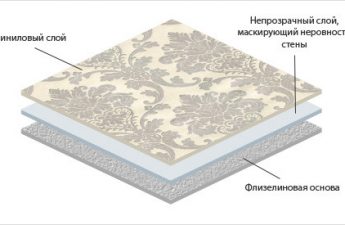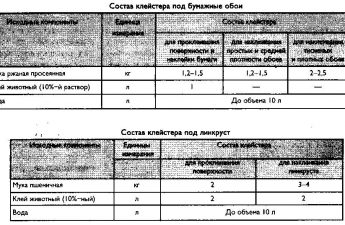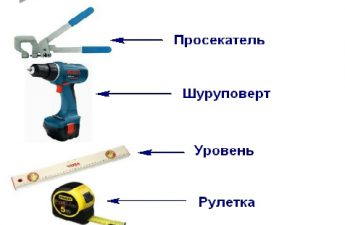It is quite possible to stick wallpaper on walls or ceilingswith their own hands, without involving professionals. Moreover, today every second person wallpapers their rooms with paper wallpaper or their more advanced analogues themselves.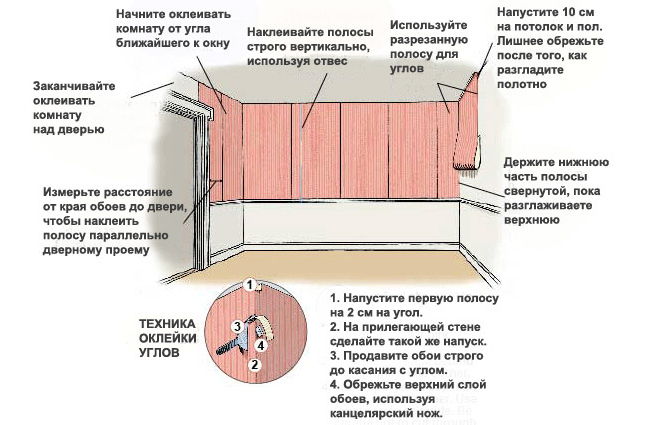 Scheme for wallpapering butt joints.How to glue wallpaper correctly - butt or overlap? Where to start gluing, what types of wallpaper exist, what glue to choose - there are many professional nuances. How, in what cases is it better to do overlaps, how - all these little things need to be known. That is why, despite the apparent simplicity of such work, the results of efforts do not always meet professional requirements. In any case, to obtain an acceptable result, it is necessary to carry out a number of consistent actions and approach each of them with the utmost responsibility and attention.
Scheme for wallpapering butt joints.How to glue wallpaper correctly - butt or overlap? Where to start gluing, what types of wallpaper exist, what glue to choose - there are many professional nuances. How, in what cases is it better to do overlaps, how - all these little things need to be known. That is why, despite the apparent simplicity of such work, the results of efforts do not always meet professional requirements. In any case, to obtain an acceptable result, it is necessary to carry out a number of consistent actions and approach each of them with the utmost responsibility and attention.
Selection of wallpaper, glue, tools
Selecting wallpaper.There are many options to choose from today: material, texture, colors, prices - for every taste. The classic of the genre is paper wallpaper. It can be single-layer or double-layer. The latter is denser and heavier. Eco-friendly, breathable, but gets wet. After drying, it can change size. Acrylic is similar to paper, but more durable and does not breathe. Non-woven is the most balanced option, can be used for painting. Velor is very elegant, but intensively accumulates dust and odors. Vinyl wallpaper is dense, durable, on a paper or textile base with a vinyl coating. It can be foamed, smooth or with the use of silk threads (silk-screen printing). It is not easy, but it is very beautiful.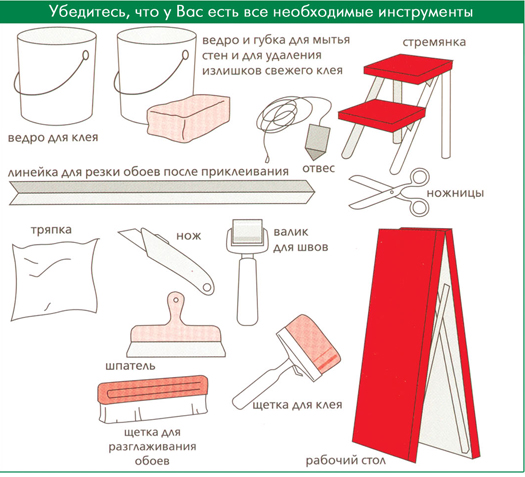 Tools for gluing wallpaper end to end.There are other types, only conditionally called wallpaper: liquid, glass, bamboo, cork. Each of these types has an original gluing technology. The most universal option is two-layer paper wallpaper. Number of rolls. When deciding on the number of rolls, you need to remember: it is better to have a reserve than a shortage. It is not always possible to buy the required type of wallpaper - different batches of this material can vary significantly. The algorithm for calculating the number of wallpaper rolls is simple. The length, width and height of the walls are measured. A standard roll of paper or non-woven wallpaper is 0.58 m wide. The length of the wallpaper strip in it is 10 m. For example, a room has parameters of 3-5 m, the ceiling height is 2.5 m. With such a ceiling height, each roll will produce 3 whole canvases - each canvas should have an overlap to match the pattern. Next, divide the perimeter of the room by the width of the roll: (3 + 3 + 5 + 5): 0.58 = 27.58 (28). The number of sheets is 28. This figure is divided by the number of whole sheets in the roll - 28: 3 = 9.3 - and rounded up. The number of rolls in this case is 10 pieces. If there is no pattern on the wallpaper, the length of the sheet can be equal to the height of the ceiling. Then the overlap is either not done at all or is minimal. Wallpaper glue. For each type of wallpaper, select your own glue according to the instructions included with the wallpaper. There are universal types of wallpaper glue, which also come with instructions for use: types of wallpaper, dilution proportions for each type, area of the surface to be treated. Necessary tools. Always have at hand:
Tools for gluing wallpaper end to end.There are other types, only conditionally called wallpaper: liquid, glass, bamboo, cork. Each of these types has an original gluing technology. The most universal option is two-layer paper wallpaper. Number of rolls. When deciding on the number of rolls, you need to remember: it is better to have a reserve than a shortage. It is not always possible to buy the required type of wallpaper - different batches of this material can vary significantly. The algorithm for calculating the number of wallpaper rolls is simple. The length, width and height of the walls are measured. A standard roll of paper or non-woven wallpaper is 0.58 m wide. The length of the wallpaper strip in it is 10 m. For example, a room has parameters of 3-5 m, the ceiling height is 2.5 m. With such a ceiling height, each roll will produce 3 whole canvases - each canvas should have an overlap to match the pattern. Next, divide the perimeter of the room by the width of the roll: (3 + 3 + 5 + 5): 0.58 = 27.58 (28). The number of sheets is 28. This figure is divided by the number of whole sheets in the roll - 28: 3 = 9.3 - and rounded up. The number of rolls in this case is 10 pieces. If there is no pattern on the wallpaper, the length of the sheet can be equal to the height of the ceiling. Then the overlap is either not done at all or is minimal. Wallpaper glue. For each type of wallpaper, select your own glue according to the instructions included with the wallpaper. There are universal types of wallpaper glue, which also come with instructions for use: types of wallpaper, dilution proportions for each type, area of the surface to be treated. Necessary tools. Always have at hand: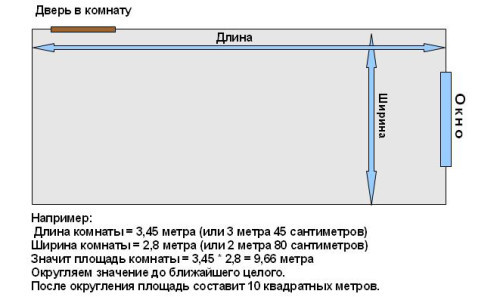 Scheme for calculating the area of a room for wallpapering.
Scheme for calculating the area of a room for wallpapering.
- bucket and basin for glue;
- stirring stick;
- nappy roller with a handle;
- set of rubber rollers;
- level or plumb bob;
- a set of putty knives;
- roulette;
- Construction knives for cutting canvases and pruning edges;
- pencil;
- rags or rags;
- brushes for glue;
- ladder.
Return to Contents</a>
Surface preparation of walls and ceiling
The surface of the walls and ceiling is thoroughly cleaned.and leveled. Protruding objects - screws, dowels, nails - are removed. Everything must be plastered, puttied and smoothed. The putty layer is primed. Sockets and lampshades are removed and de-energized. Markings are applied to the surface prepared for pasting. The ceiling bevel line is measured and drawn if a baseboard is not provided. Using a level or plumb line, a vertical line is beaten off on the wall - the beginning of pasting the first canvas. Since two-layer paper wallpaper is glued end to end, you can start pasting from any convenient place. Return to contents</a>
Marking and slicing of wallpaper
You can use it as a table for cutting wallpaperuse a sheet of plasterboard or plywood placed on a regular table or trestles. Length from 2 to 3 m, width - from 1 to 1.5 m. The length of the canvas is determined by the height of the ceiling, taking into account the overlap for adjusting the pattern (if any). A mark is made on the cutting table from the edge. The roll is rolled out and applied to the mark. The canvas of the required length is cut with a construction knife. In this way, the required number of canvases is cut. Return to the table of contents</a>
Spreading the surface and wallpaper with glue
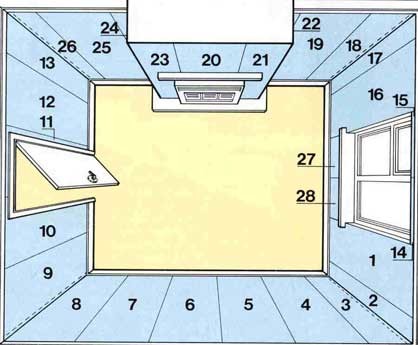 Wallpaper pasting sequence.If you are gluing paper or vinyl wallpaper, then both the canvas and the walls are coated with glue. The canvas is unrolled on the cutting table, evenly coated with glue using a brush or roller, folded inward and left to soak. The soaking time is indicated in the instructions. Then a layer of glue is applied to the wall with a brush. If the wallpaper is non-woven, only the wall is coated. Return to contents</a>
Wallpaper pasting sequence.If you are gluing paper or vinyl wallpaper, then both the canvas and the walls are coated with glue. The canvas is unrolled on the cutting table, evenly coated with glue using a brush or roller, folded inward and left to soak. The soaking time is indicated in the instructions. Then a layer of glue is applied to the wall with a brush. If the wallpaper is non-woven, only the wall is coated. Return to contents</a>
Adhesive wallpaper, smoothing
How to glue paper wallpaper?The first sheet is applied to the vertical marking line from above along the entire length, aligned and smoothed with a rubber roller. Air bubbles and folds are removed. The next sheet will be glued end-to-end with the previous one. The edges of the sheets at the joints are especially carefully smoothed. Excess glue on the sheet is removed with a rag. Pasting corners: if the corner is not perfectly even, then an overlap of 1-3 cm is made in the corner itself. After this, using a spatula, both sheets are cut with a construction knife along the overlap. The lower strip is removed. You get an even joint. It is better to paste over a perfectly even corner with a single piece and make the joint on the opposite wall. Return to contents</a>
Correct trimming of edges
Excess and protruding edges of the wallpaper are cut offwith a construction knife using a spatula. It is better to do this dry to avoid tears and creeping. In some cases, scissors can be useful for cutting wet pieces or cutting holes for sockets and lampshades. To glue wallpaper without negative consequences, you need to take care of the right temperature in the room. It should be at least 20 °. The walls should not be damp. What kind of wallpaper is better to glue - paper, vinyl, non-woven? This question is decided individually. Each type of wallpaper has its own advantages and disadvantages. For example, it is better not to glue single-layer paper wallpaper at all - they creep in your hands when spreading with glue, change size after drying, tear, etc. And if you do glue, then only overlap and with a large overlap. Vinyl wallpaper is quite popular today. They are very beautiful, quite strong and durable. But not all surfaces can be covered with vinyl wallpaper. Vinyl wallpaper should be glued only on well-prepared walls. Vinyl wallpaper is glued end-to-end, so if the corners or walls are uneven, it is no longer possible to align them by overlapping. Non-woven wallpaper is good, it is probably the most balanced in all respects, but it is more expensive than paper. Whatever wallpaper is chosen, the main thing is to glue it carefully and slowly, then an excellent result will certainly be achieved.
